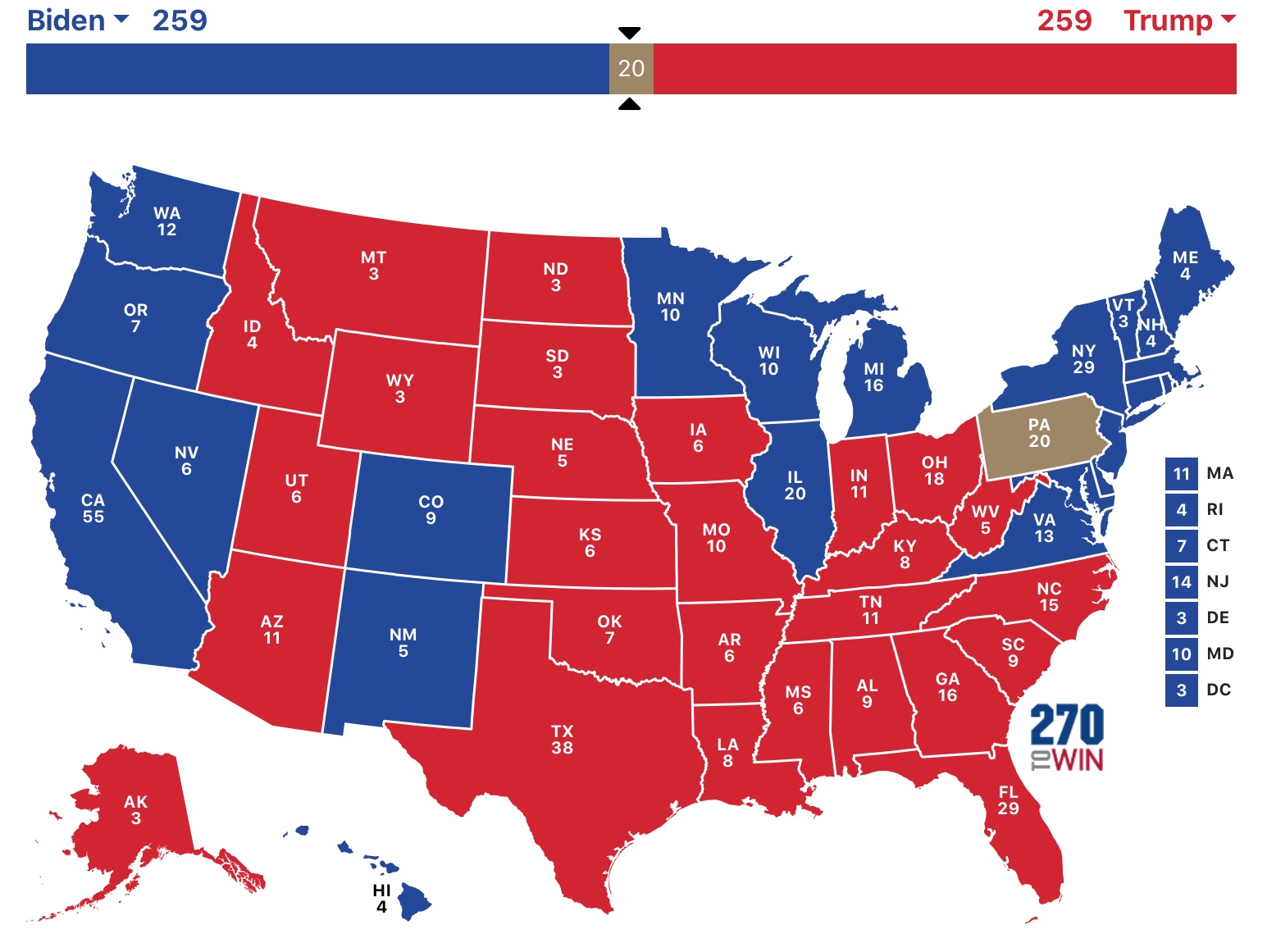Tuesday afternoon, we posted our predictions for election night and, ultimately, the outcome of the election.
We got a few things right, but let’s start off with what we got wrong.
What We Got Wrong
Arizona, Nevada, Georgia, North Carolina, Michigan, Wisconsin Being Decided On Election Night
This came down to two separate, but conjoining factors: each state’s methodology for counting mail-in ballots per state law (such as counting before Election Day) and how competitive each state ultimately became once those ballots were beginning to be tallied.
As it turns out, most major polls which considered Arizona, Georgia, and North Carolina as “competitive” were, generally, right.
Biden Flipping Arizona and, very likely, Georgia
In Arizona, which actually has yet to be called by some major news outlets, pundits have accredited the flip to the growing Latino vote as well as heavy migration from tax-burdened California into the Phoenix suburbs. Regardless of how this happened, the state of The Conscience of a Conservative’s Senator Barry Goldwater, simply couldn’t muster another four years of Trump.
If the results hold in Georgia, Democrats owe a huge debt of gratitude to Stacey Abrams’ continued efforts to turn the state blue since her 2018 defeat in Georgia’s gubernatorial race. In January, however, we’ll get our first hint into just how permanent this shift has become as incumbent Republican Senator, David Perdue will face-off against Democratic challenger, Jon Ossoff, in a run-off for Georgia’s US senate seat.
What We Got Right
Trump Won Ohio and Florida
Ohio continued to vote with their pocketbook and their eyes. Innovation and job migration out of the state during the Obama-era was the drum that Trump and the GOP continued to bang in Ohio and it worked, continuing the state’s shift to the right.
Biden’s and the Democratic party’s inability to distance themselves from Trump’s “socialist” rhetoric continued to spook Cuban-Americans living in South Florida. Biden lost 23 points of a Democrat advantage in Miami-Dade, specifically attributed to Cuban-Americans.
This year’s electorate, however, could have potentially given us a peek into, potentially, new battleground states such as Arizona and Georgia. As both respective states continue to see population surges, especially Arizona, their electoral votes will continue to rise and make their states significantly more consequential on election night.
Pennsylvania Was Not Decided On Election Night
Of the major battleground states, we picked only Pennsylvania to be the holdout, due to their insurmountable task of counting a record number of mail-in ballots beginning on Election Day and how competitive it could have potentially been, and ultimately, was.
Either Biden Would Win On Election Night or Biden/Trump Would Win Later
This was based on our analysis that Trump’s path to the presidency solely landed on winning Pennsylvania, which we didn’t believe would be called on that night. Biden, however, had other potential paths to victory outside of Pennsylvania, including the minuscule chance of pulling out Ohio and Florida on election night.
Every Hidalgo County Republican Running Lost
Democrats swept their respective U.S. and State house races, District Judge-elect Joe Ramirez unseated his appointed Republican opponent for the 464th District Court, Ysmael Fonseca, and Hidalgo county re-elected a Pringles logo as their county sheriff.
That’s not to say that some of these races weren’t competitive, however. Vicente “Chente-Con La Gente-Ya Vete” Gonzalez almost blew his Democrat cushion against his GOP challenger, Monica De La Cruz-Hernandez, pulling out the victory by only 3 percentage points. I guess he just ran out of Popeyes this time around.
When The Dust Settled, Biden Won
For now, let’s pretend for a minute that we live in a reality where a quarter of the country doesn’t believe the bat-shit theories like Trump watermarking every single god-damn ballot printed in every printing press for every county in the country.
Regardless of Trump’s crack legal team signing their names of insane petitions that are being thrown out of every court as we speak, Biden won the election outright.
What We Got Half-Right, Half-Wrong
Texas Stayed Red, But It Wasn’t Really That Close
In 2016, Trump won Texas by 813,774 votes, equating to an approximately 9.2 percentage point win. At the time of this posting, it looks like Trump will win by, more or less, 656,000 votes, equating to an approximately 5.9 point win.
In the face of a potential blue wave, the Texas Republican Party answered the bell by focusing on creating new battlegrounds, especially in parsing the Latino vote in South Texas.
Granted, Democrats made inroads into Texas, shaving off a 200,000 of the vote deficit, but any notion of Texas turning “blue” this election cycle should have been summarily dismissed.








